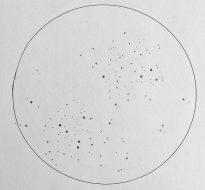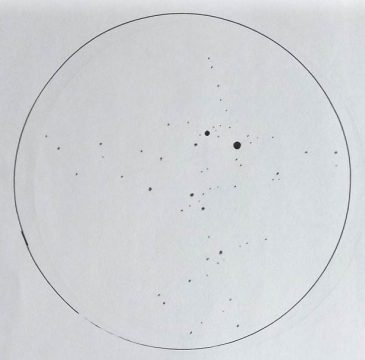Why, and how, you should sketch your observations through a telescope.

D. Rennie
In the late-1990s, I wrote an essay for a literary journal and cited two quotes: one from an 1851 anonymous French book collector (“Owning a book puts it in your possession, but only reading a book makes it yours”) and the second from renowned literary critic Edmund Wilson (“No two persons read the same book”) Both quotes relate to why I made sketching a regular component of my observing routine.
When you locate and observe a celestial object, it produces a visual experience and another checked box on your “objects seen” list. You move on to the next target, and just as quickly to the one after that. The impression of the object you observed only minutes ago is already dim and quickly being forgotten.
But that’s not the case if you regularly sketch what you observe. You have to slow down and actually study what you see in the field of view. You look at it through various eyepieces, see it in its entirety — close, large, and bold — and as part of a larger celestial context — smaller, and more subdued.
Then you put pencil to paper and sketch it, one star at a time.
Or perhaps you sketch it twice: once at a high magnification to capture all the detail and maximum star count, and a second time to see the object and the surrounding star field, the total celestial tapestry. By the time your sketch is done, you will have spent a half hour, sometimes more, in the company of this single object. Moreover, you will have a permanent and personal hard copy of what you observed. In the spirit of the Frenchman, you will have made the object yours.
And in the spirt of Wilson, no two observers see the same object. If you visit a sketching site, such as Deep Sky Archive or Astronomy Sketch of the Day and look up any object, you will see a dozen sketches, often more, by different observers – and no two look remotely alike. You would think you were looking at sketches of 12 different objects. Over a year ago, S&T Contributing Editor Sue French introduced me to this site and I thought it’d be a great place to reference for my first-time searches. While I found the sketches useful, they were also confusing. Even something as clear and uncomplicated as the Pleiades will have as many variations as there are sketches.
This isn’t a bad thing: it’s one more reason to make every object “yours” by laying out on paper the testimony of your visual senses for each object you observe on that night in those skies with that instrument and those eyepieces.
I’ve been observing for just over three years, but my background is in the humanities. I have zero expertise — or close to zero — in the hard sciences. I am primarily an observer who enjoys taking in the beauty of the nighttime sky. I pay scant attention to technical details and just go hunt down what I want to observe. Once I have found the object in the eyepiece, I leave it there for a while. Sometimes I do a sketch.
The Sketching Process
I began to sketch almost as soon as I started observing, but my early sketches would have made third graders laugh at how bad they were. As with most things, my sketches have gotten better the more I practice. My favorite objects are open clusters. I prefer to look at them through one of my refracting telescopes as opposed to my Dobsonian telescopes. With a Celestron 8-to-24-mm zoom eyepiece in place for the first observation, I can change the magnification: up close with the maximum number of stars – or the widest field possible, which puts the object in context to the other stars in the sky. Once I find the ideal magnification, I use one of my fixed focal length eyepieces, often an ES 16 mm or Agena flat-field 19 mm. Then I actually start to sketch the celestial object.

D. Rennie
I have a small lined notebook that I use at the telescope to record a very rough first draft. I focus on getting accurate relative positions of the stars, taking care to use different sized dots for individual stars to represent their brightness. I start with the outermost stars in all four directions, just to make sure that I get the entire image I want. Then I sketch the biggest or brightest stars to get the main pattern. Once this is done, I work outward from there, one section at a time.
The next day, I transfer the image onto my artist’s sketchbook, often using a plastic template for the larger stars to ensure I get perfectly round dots. When I have completed the entire sketch, I trace over the larger stars with a darker pencil to distinguish them from the other background stars, and so they look as they do through the eyepiece. In fact, I often take the final draft out one more time and fine tune the sketch based on what I see through the eyepiece.
This is what works for me – and I was thrilled to have one of my renderings appear among so many other fine sketches in June’s Sky & Telescope. What works for you might be completely different. In any case, I’d like to think that this centuries-old technique is seeing a resurgence of interest. With the current fixation on astrophotography, it might be time for a retro focus on the Old School methods.
 2
2









Comments
Mark-Dufrene
June 29, 2016 at 9:24 am
Nice article, Doug. I find sketching more connecting to the night sky than astrophotography. It's more relaxing, with less stuff to mess with. It's a shame that the ASOD site is on hiatus, but fortunately the archive is still active.
You must be logged in to post a comment.
john-tudek
July 11, 2016 at 1:44 pm
Great article! I've been sketching off and on for several years now. The idea of posting my sketches on the internet never occurred to me, but its a great idea. Maybe the sketch-a-day thing should be revived.
You must be logged in to post a comment.
You must be logged in to post a comment.